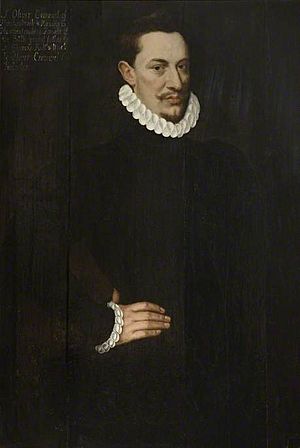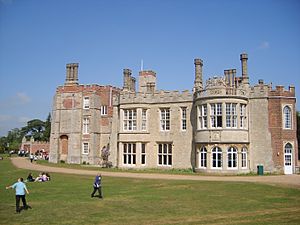Sir Oliver Cromwell facts for kids
Quick facts for kids
Sir Oliver Cromwell
|
|
|---|---|

Sir Oliver Cromwell (1563–1655), c. 1589, Hieronymus Custodis (circle of)
|
|
| Member of Parliament for Huntingdonshire | |
| In office 1589–1625 |
|
| Personal details | |
| Born | c. 1562 |
| Died | 28 August 1655 (aged 92–93) |
| Resting place | Ramsey Abbey, Ramsey, Huntingdonshire 52°26′54″N 0°06′03″W / 52.44833°N 0.10083°W |
| Spouses | Elizabeth Bromley Anne Hooftman |
| Children | with Elizabeth:
|
| Parents | Sir Henry Williams (alias Cromwell) Joan Warren |
Sir Oliver Cromwell (born around 1562, died 1655) was an important English landowner, a lawyer, and a politician. He was a member of the English Parliament, called the House of Commons, many times between 1589 and 1625. He is also famous for being the uncle of the more well-known Oliver Cromwell, who later became the leader of England, known as the Lord Protector.
Contents
Biography
Early Life and Public Service
Oliver Cromwell was born around 1562. He was the oldest son of Sir Henry Williams, also known as Cromwell, and his mother Joan. His grandfather, Sir Ralph Warren, was a very important person who served as the Lord Mayor of London.
Oliver studied at Queens' College, Cambridge, and later became a lawyer. He lived in a town called Godmanchester until his father passed away.
He held several important jobs in his local area. In 1585, he was a captain in charge of soldiers for Huntingdonshire. When the Spanish Armada threatened England, he helped lead the men from Huntingdonshire. He also served as a judge for the town of Huntingdon in 1596.
From 1598 to 1599, he was the Sheriff of Cambridgeshire and Huntingdonshire. A sheriff was a very important local official, like a chief law enforcement officer. While he was Sheriff in 1598, Queen Elizabeth I might have made him a knight.
Sir Oliver was also a Justice of the Peace, which meant he helped keep law and order. He started this role around 1585 but was removed for a short time in 1587. However, he was put back in his position in 1594 because he was so important to the small county of Huntingdonshire.
Serving the King
Sir Oliver Cromwell was first elected as a Member of Parliament for Huntingdonshire in 1589. He was re-elected many times, serving in Parliament in 1593, 1597, 1601, 1604, and 1614. After a short break, he was elected again in 1624 and 1625.
He was known for being very wealthy and important. On April 27, 1603, he hosted King James I at his home, Hinchingbrooke House. The King was traveling south to become the new King of England. Sir Oliver gave the King amazing gifts, including "a cup of gold, goodly horses, deep-mouthed hounds, and divers hawks of excellent wing." It was said to be the biggest party ever given to a king by a regular person!
Because of his loyalty and generosity, King James made him a Knight of the Bath at his coronation in July 1603. Sir Oliver also became a lawyer for Queen Anne of Denmark and a gentleman in the King's private rooms.
In 1604, Sir Oliver's father died, and he inherited Hinchingbrooke House and all the family's lands. He also took over his father's job as the Custos Rotulorum of Huntingdonshire, which meant he was the chief keeper of the county's records.
King James I visited Hinchingbrooke House often, almost treating it like his own home. By 1623, Sir Oliver was trying to sell Hinchingbrooke to the King because he had many debts. However, King James I died in 1625, and the sale did not happen. Sir Oliver finally sold Hinchingbrooke House in 1627 to Sir Sidney Montagu. He also sold other lands to pay off his debts, and he was left with property only in Ramsey, Cambridgeshire.
Later Years and Family Ties
When the English Civil War began, Sir Oliver Cromwell remained loyal to the King. His nephew, also named Oliver Cromwell, who later became the Lord Protector, was sent by Parliament to search Sir Oliver's home in Ramsey for weapons. It is said that the younger Oliver showed great respect to his uncle during this visit.
Later, Sir Oliver's lands in Ramsey were taken away, but they were given back to him in 1648. This happened because of the influence of his powerful nephew, who had become the leader of England.
Sir Oliver Cromwell died in 1655. He was buried in Ramsey on the same day, August 28, to prevent his body from being taken by people he owed money to. It is believed he died after falling into a fireplace while trying to dry himself after being out in the rain.
Family and Children
Sir Oliver Cromwell was married twice. His first wife was Elizabeth Bromley. With her, he had four sons and four daughters:
- Henry
- John
- William
- Thomas
- Hannah
- Katherine
- Jane
- Elizabeth
His second wife was Anne Hooftman, whom he married in 1601. She was the widow of a wealthy financier. With Anne, he had two more sons and two daughters:
- Oliver
- Giles
- Mary
- Anne
In total, Sir Oliver had twelve children. He himself was the oldest of eleven brothers and sisters. Interestingly, two of his sons from his first marriage later married two of Anne's daughters from her first marriage.
His second son, John, married Abigail Clere. Sir Oliver was also the brother of Robert Cromwell, who was the father of the famous Oliver Cromwell, the Lord Protector.


